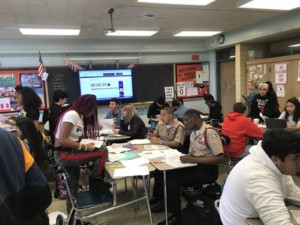3 Ways to Empower Common Core Writing

Common Core writing demands a level of complexity and quality that requires students to engage with text, synthesis information and come to a conclusion or form an opinion. This type of writing is introduced to students in the early grades as part of a spiraling set of skills that focuses on core conceptual understandings and procedures. The standards increase in complexity as students progress through school.
The Common Core writing standards were designed to provide teachers with a framework and adequate time to help students achieve mastery of skills necessary to succeed in school and beyond. While the standards identify what students should be able to do, the accompanying instructional shifts present a big picture view of changes in traditional teaching methods that are necessary to effectively implement those standards.
CCSS Shift 5, Writing from Sources, requires students to construct knowledge through research and present evidence that is accurate, precise and clear. Regularly engaging students in this type of real world writing will foster the development of essential skills. The Common Core does break this big shift into specific standards by grade level, but the suggested changes might seem overwhelming to teachers who are using traditional teaching methods, even if augmented by technology.
Technology can be a powerful tool to facilitate changes in writing and research that can transform traditional assignments into engaging, deep learning experiences if used effectively, but real learning gains can only be achieved if the technology is used in a way that requires students to make decisions, process information and formulate ideas based on research. Here are some tools and strategies that use technology to transform traditional writing tasks and take advantage of technology as an efficient tool for the type of deep learning experiences suggested by the Common Core.
Start with an Essential Question
An essential question can inspire students to become truly engaged in a research based writing task. Good essential questions are complex and connected to the world in which students live. These types of questions can tap into student’s enthusiasm for inquiry and help them develop ideas that are expressed through writing. The questions provide students with challenges that allow them to become invested in the learning process as they make decisions and choose their own learning paths. With appropriate support, students at all instructional levels should be able to successfully answer an essential question, while students at the highest levels should be able to find challenges.

Embrace Research
As educators we are faced with the challenge of teaching students to efficiently use the Internet to find and use information. Searching for reliable information and making sense of it is a process that involves critical thinking and it is important to help students develop those skills. Evaluating website credibility is also an important skill we must help students develop.
Let’s face it, outside of the classroom most of us are not given a list of websites to search when we are expected to present information to our colleagues or when we need to find solutions to every day problems. For this reason, I’d like to suggest that providing students with links to pre-identified websites and requiring them to search for answers to basic questions is not a particularly beneficial part of the research based writing process either. It is; however, a way to ensure that students access credible and appropriate websites during their earliest school research experiences, and many teachers believe it is a step in the right direction. Here are some ways to use Google tools to help students progress through the stages of learning to search and help them avoid the pitfalls when faced with an overwhelming amount of information to sort through in a regular Google search.
Google Custom Search
The Google Custom Search tool provides educators with the ability to build a search engine that only searches websites chosen to be credible and appropriate for the task. This might sound complicated, but Google has made it as easy as can be. Just collect links to preselected websites that are credible and age appropriate, log in to Google Custom Search and pop the web addresses into a box. Once you’ve created a custom search engine, it can be embedded into a website, blog or wiki for easy student access.
Research Tool in Google Docs
If your students have access to Google Docs, you can take advantage of the built in Research Tool that displays a mini search engine right on the page of any Google document. Just click on the Tools Menu to access the research tool and pop a search term into the box. The tool limits the results to display a manageable amount of information. Students can use the drop-down menu to narrow a search to find images, quotes, definitions or scholarly articles. Create citations with the click of a button to introduce students to the concept of citing sources. Use the Google Doc itself for taking notes and be sure to take advantage of the Insert Link to quickly create a link back to the original article.
Google Search Tools – Search by Reading Level
Provide Support for Struggling Readers
In nearly every classroom there are a few students who do not have the reading level needed to comprehend written content-based material. This creates a barrier that prevents them from being able to formulate ideas based on research . One of the biggest challenges teachers face is providing text for struggling readers. Technology is a tool that can help. Here are a few tools for providing students with the support they need to succeed
Text Compactor
Text Compactor is a free online tool for summarizing and simplifying text. It is extremely user-friendly and requires no login so it’s a perfect tool for students to add to their own toolkits of resources. Just copy and paste some digital text into the box, use the slider to determine the percentage of text you want to end up with, and view the simplified text. Add a text to speech tool to the mix if students are still unable to read the simplified text.
Readability
Readability is a tool that scrubs webpages clean of distractions by eliminating the ads and creating a more readable version of digital text. White space in between lines of text increases for a more comfortable read, and only primary images are displayed. The handy tool is available as a chrome extension, a bookmarklet for most popular browsers, and an app for iDevices, Android and Kindle.
Lingro
Lingro is a useful tool that turns any website or digital text file into an interactive dictionary. Users can click on a word to view it’s definition and often hear it’s pronunciation. Lingro supports by languages, which makes it a useful tool for ELL students as well. To use Lingro, just copy and paste any web address into Lingro’s web browser and click on a word to view it’s definition. Get the handy bookmarklet for easy access.
Final Thoughts
In order to meet the demands of the Common Core writing standards, teachers must provide students with frequent opportunities to engage in research based writing that require them to dig deep into content, synthesize information and formulate ideas based on evidence. Student driven learning experiences fueled by essential questions and powered by digital tools can be the key to helping our students develop powerful skills to help them succeed in college and in life.




Keri
Thank you, Susan - theses are exactly the tools I need! I get overwhelmed with all the available resources - where to start? I am excited to try these with my ELLs and struggling students.
Replies
SusanOxnevad
So happy you have found some useful tools here, Keri. Best of luck to you!
Divyang
Rightly said! A demanding situation like this certainly required Natural Language Processing tools such as https://www.machinewrites.com/summarization